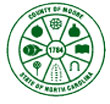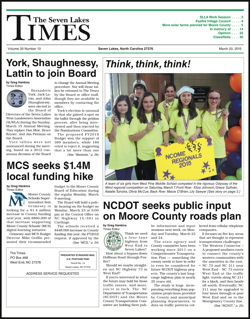 The expansion plans for a Seven Lakes mini-storage business won the approval of the Moore County Planning Board, which voted unanimously on Thursday, November 8, to revise a conditional use permit sought by Euromax, LLC.
The expansion plans for a Seven Lakes mini-storage business won the approval of the Moore County Planning Board, which voted unanimously on Thursday, November 8, to revise a conditional use permit sought by Euromax, LLC.
The firm, owned by Moore County GIS Director Chris Koltyk, currently operates an mini storage facility on a 0.69-acre lot at 140 Auman Street, an unpaved road that runs between Trade and MacDougall in Seven Lakes Business Village.
The new conditional use permit covers that lot and an adjacent 0.344 acre lot recently acquired by Euromax. The additional acreage allowed a configuration of the site plan for the property, which could eventually hold six storage buildings, one of which includes a woodworking shop, surrounded by a perimeter fence. There is currently one building on the site.
The revised conditional use permit requires that the lots be formally recombined prior to development. It limits building height to sixteen feet, imposes standards for outdoor lighting, and prohibits outdoor storage.
Noting that another, nearby storage business in the Village offers outdoor storage, Planning Board member Rodney Pickler questioned that restriction. Planner Tim Garner explained that the zoning ordinance prohibits outdoor storage, but the existing other storage facility predates the development of the ordinance and thus is grandfathered, as an "existing, non-conforming use." The use can continue, but it can't be expanded, Garner said.
Answering question from other members of the panel, Garner explained that the conditional use permit includes no setback requirements, because the Seven Lakes Village Business District has no setback requirements in the Zoning Ordinance. There are no buffering or screening conditions on the permit, because it is surrounded by other commercial properties.
Watershed Ordinance Changed
Developers will be able to pair two noncontiguous properties that lie in the same watershed in order to meet development density standards, under a modification to the Watershed Overlay District section of the Zoning Ordinance unanimously approved by the Planning Board during Thursday's meeting.
The change brings the ordinance into conformity with legislation passed by the NC General Assembly.
The Watershed Overlay District rules are designed to protect land that feeds public drinking water supplies, by controlling storm water runoff. They limit the amount of a given property that can be covered by impervious surfaces -- buildings, parking lots, gravel driveways -- and give the county Watershed Review Board the discretion to modify those standards within certain parameters.
The new rules allow a developer who owns two properties in the same watershed -- even if they are separated by miles -- to present a development plan that includes both properties and average development density across both properties.
For example, if two lots in the same watershed could each be covered by a maximum of thirty percent impervious surface, the new ordinance would allow density to be averaged across the lots, increasing the allowed density on one, while permanently reducing it on the other. So, the developer could up the density on one lot to forty percent, borrowing ten percent from the other lot, but that would permanently reduce the density allowed on the second lot to twenty percent.
Planning Board member Les Murray, a builder, gave an example of when this might be advantageous.
"Where this would make sense is if you owned a tract near town, where you'd like a higher density, and you own another one further from town where you wouldn't want the density -- where that density might not even be salable."
The new rule does not allow a developer to increase the density of a tract in the area of the watershed closet to a public water intake, the "Critical Area."
A number of Board members expressed concern that the developer's trade-off would be permanently recorded, and Planner Tim Garner explained that the plans for both tracts would be linked and flagged in the records maintain by the Register of Deeds.
The discontinuous lots to be "combined" for the purpose of density averaging must be in the same watershed -- and also within a single local government's jurisdiction, Garner explained. So, a developer could not use a lot on Moore County along with one in Hoke County for the purpose of averaging. Nor could they use a lot that falls under the jurisdiction of Moore County with one that falls under the jurisdiction of one of the county's municipalities, Foxfire Village, for example, because the towns and villages manage their own Watershed Overlay Districts.
Other Business
In other business during the Planning Board's Thursday, November 8 meeting:
• Planning Director Debra Ensminger told the Board that its Thursday, December 6 meeting would include consideration of revision to the sign ordinance.
• Ensminger said the Moore County Board of Commissioners are expected to begin their review of the proposed Unified Development Ordinance in January.
• Assistant County Attorney Brenda White briefed the Board on a recent meeting of the Board of Adjustment, in which that panel unanimously recommended to the Board of Commissioner that the County appeal a Superior Court ruling that prevented the Seven Lakes Aeromodelers Club from using a tract of farmland near West End. The Commissioners will take up that recommendation in a Special Meeting on Tuesday, November 13, at 9:30 am.
